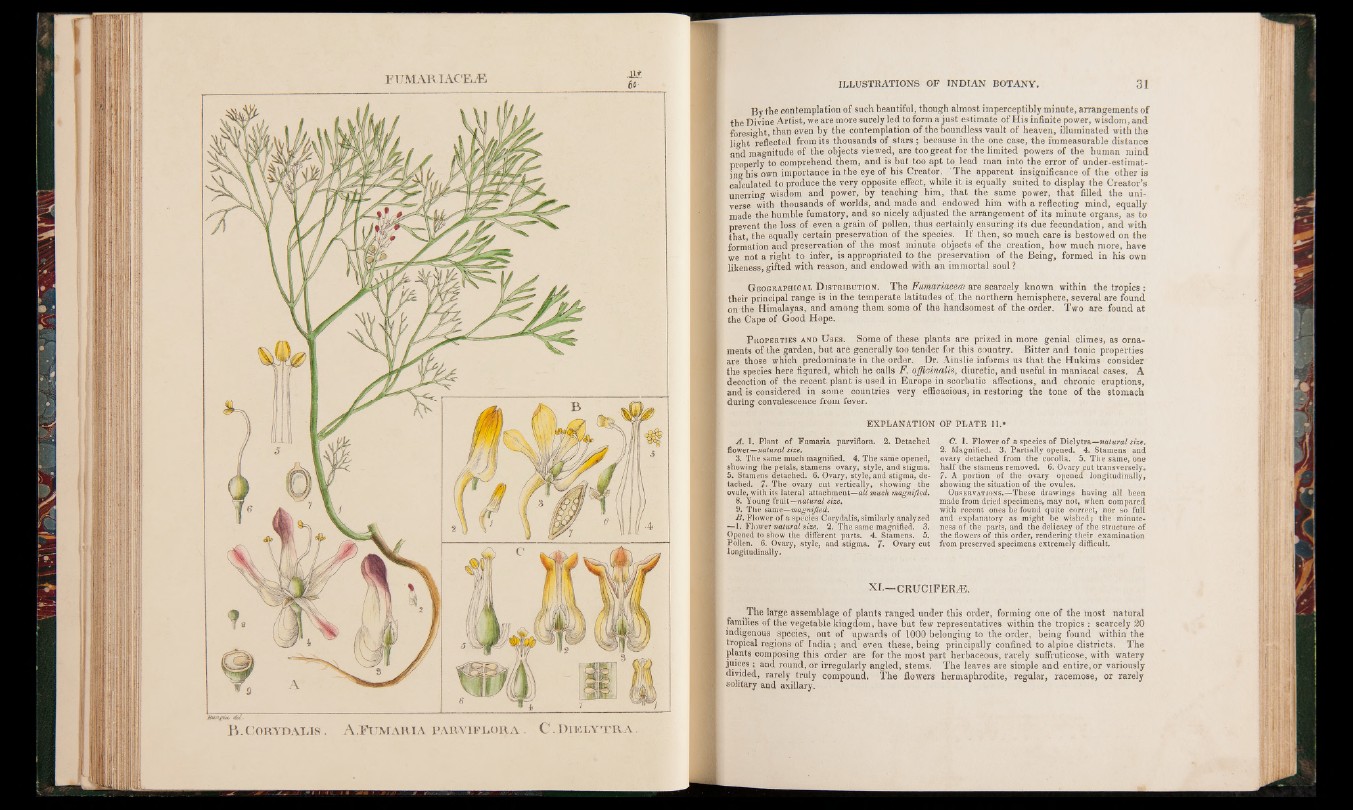
By the contemplation of such beautiful, though almost imperceptibly minute, arrangements of
the Divine Artist, we are more surely led to form a just estimate of His infinite power, wisdom, and
foresight, than even by the contemplation of the boundless vault of heaven, illuminated with the
light reflected from its thousands of stars; because in the one case, the immeasurable distance
and magnitude of the objects viewed, are too great for the limited powers of the human mind
properly to comprehend them, and is but too apt to lead man into the error of under-estimating
his own importance in the eye of his Creator. The apparent insignificance of the other is
calculated to produce the very opposite effect, while it is equally suited to display the Creator’s
unerring wisdom and power, by teaching him, that the same power, that filled the universe
with thousands of worlds, and made and endowed him with a reflecting mind, equally
made the humble fumatory, and so nicely adjusted the arrangement of its minute organs, as to
prevent the loss of even a grain of pollen, thus certainly ensuring its due fecundation, and with
that the equally certain preservation of the species. If then, so much care is bestowed on the
formation and preservation of the most minute objects of the creation, how much more, have
we not a right to infer, is appropriated to the preservation of the Being, formed in his own
likeness, gifted with reason, and endowed with an immortal soul ?
G eographical D ist r ibu t io n . The Fumariacece are scarcely known within the tropics :
their principal range is in the temperate latitudes of: the northern hemisphere, several are found
on the Himalayas, and among them some of the handsomest of the order. Two are found at
the Cape of Good Hope.
P roperties and U s e s . Some of these plants are prized in more genial climes, as ornaments
of the garden, but are generally too tender for this country. Bitter and tonic properties
are those which predominate in the order.. Dr. Ainslie informs us that the Hukims consider
the species here figured, which he calls F. officinalis, diuretic, and useful in maniacal cases. A
decoction of the recent plant is used in Europe in scorbutic affections, and chronic eruptions,
and is considered in some countries very efficacious, in restoring the tone of the stomach
during convalescence from fever.
EXPLANATION OF PLATE 11.*
A . 1. Plant of Fumaria parviflora. 2. Detached
flower—natural size.
3. The same much magnified. 4. The same opened,
showing the petals, stamens ovary, style, and stigma.
5. Stamens detached. 6. Ovary, style, and stigma, detached.
7- The ovary cut vertically, showing the
ovule, with its lateral attachment—all much magnified.
8. Young fruit—natural size.
9. The same—magnified.
B . Flower of a species Corydalis, similarly analyzed
—1. Flower natural size. 2. The same magnified. 3.
Opened to show the different parts. 4. Stamens. 5.
Pollen. 6. Ovary, style, and stigma. 7. Ovary cut
longitudinally.
C. 1. Flower o f a species of Dielytra—natural size.
2. Magnified. 3. Partially opened. 4. Stamens and
ovary detached from the corolla. 5. The same, one
half the stamens removed. 6. Ovary ^ut transversely.
7. A portion of the ovary opened longitudinally,
showing the situation of the ovules.
Observations.—These drawings having all been
made from dried specimens, may not, when compared
with recent ones be found quite correct, nor so full
and explanatory as might be wished; the minuteness
of the parts, and the delicacy of the structure of
the flowers of this order, rendering their examination
from preserved specimens extremely difficult.
XL—CRUCIFERA3.
The large assemblage of plants ranged under this order, forming one of the most natural
families of the vegetable kingdom, have but few representatives within the tropics : scarcely 20
indigenous species, out of upwards of 1000 belonging to the order, being found within the
tropical regions of India ; and even these, being principally confined to alpine districts. The
plants composing this order are for the most part herbaceous, rarely suffruticose, with watery
juices ; and round, or irregularly angled, stems. The leaves are simple and entire, or variously
divided, rarely truly compound. The flowers hermaphrodite, regular, racemose, or rarely
solitary and axillary.